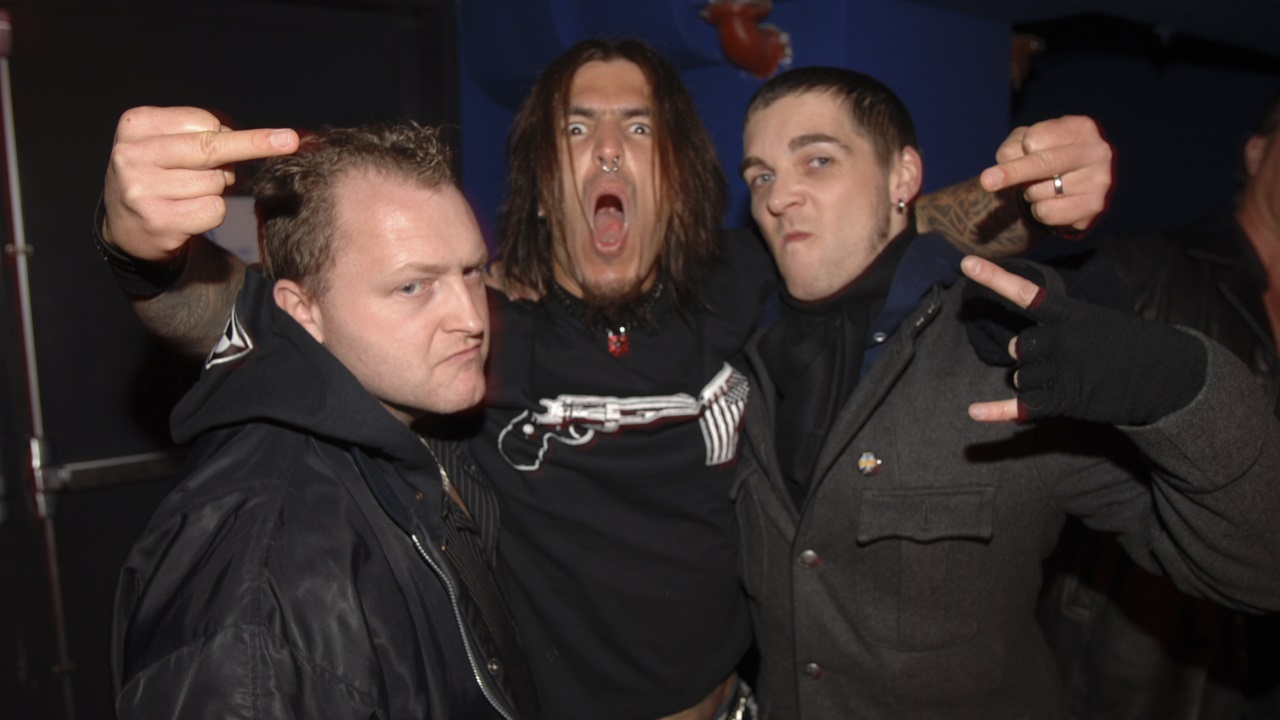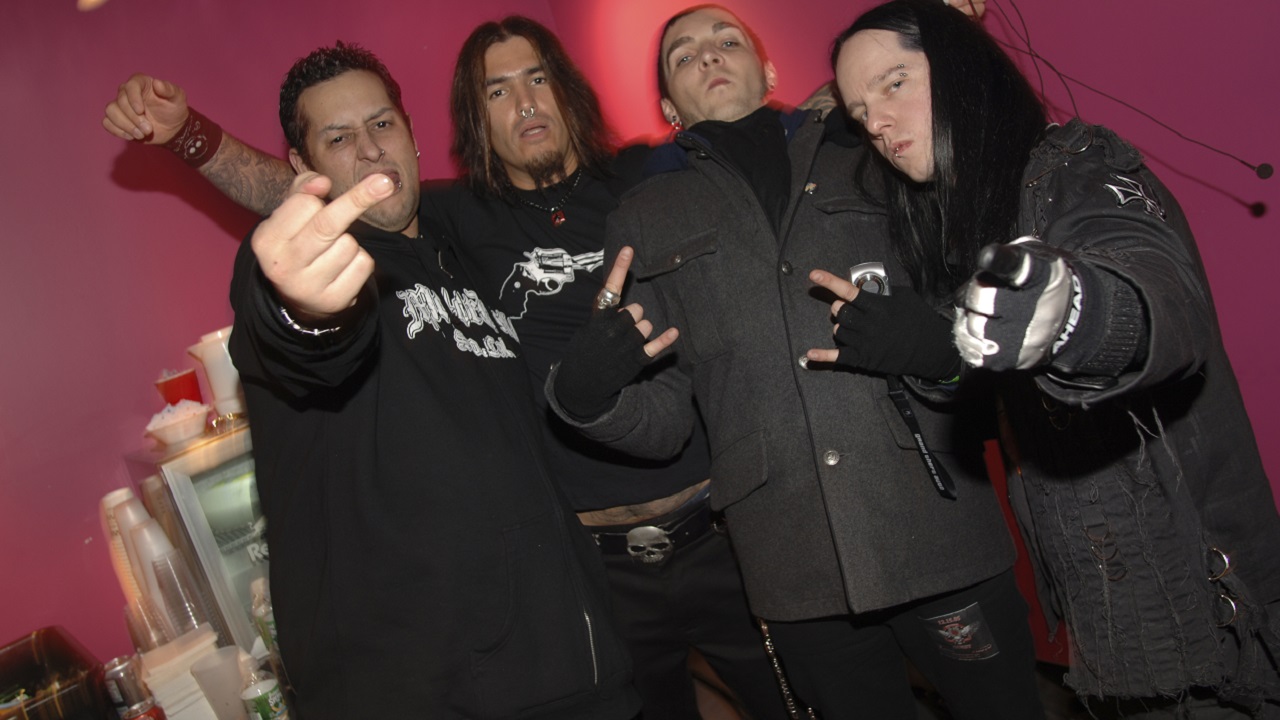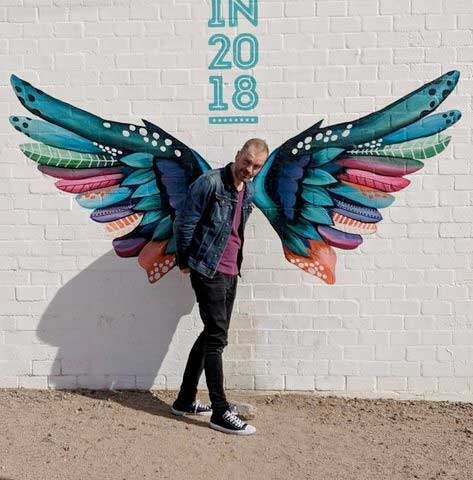In 2004, Roadrunner Records founder Cees Wessels called a meeting. The man who had started the label in Holland in 1980 wanted to mark its approaching 25th anniversary, and he was looking for ideas.
“There were all the usual suggestions for books and documentaries,” says Monte Conner, at the time the label’s Senior VP of A&R and someone who worked for Roadrunner from 1987 to 2012. “But in typical Cees fashion, he went, ‘Go broke or go home.’ He wanted to do something big.”
It was Monte himself who hit on the biggest idea of all: an album featuring brand-new songs written and performed by an all-star line-up of Roadrunner musicians past and present. And it was Monte who was tasked with turning this epic undertaking into reality.
The project, christened Roadrunner United, spawned 2005’s All-Star Sessions album, a one-off gig and a live record/ DVD. It was more than just an anniversary celebration - it was confirmation of the place the label had carved out for itself at the centre of metal culture over the previous decade.

The seed for Roadrunner United was planted by Mark Palmer, who ran the label’s UK office. He suggested enlisting a group of ‘name’ Roadrunner musicians to record a single to mark the label’s anniversary. Monte Conner liked the idea, but figured they could take it further.
Monte: “I thought, ‘Why don’t we make it a full-blown album?’ The closest thing I could think of was the Probot record, where Dave Grohl wrote a bunch of songs and got in a guest singer for each track. I was, like, ‘Let’s do that, but on an even bigger level.’”
Dino Cazares (Fear Factory): “People loved Roadrunner Records. If you bought a record that had the Roadrunner label on it, you knew you were going to like it.”
Matt Heafy (Trivium): “It was a cultural force. You weren’t just into a band or two from Roadrunner, you were into everything the label put out. I knew that from being a fan myself. For us, we had such a kinship to everyone we were signed with.”
Monte: “We had maybe 12 to 14 months to get this thing ready and released. That is not a lot of time for a regular record, let alone something like this. It was, like, ‘Oh fuck, how am I gonna get this done?’”
His solution was to appoint four ‘team captains’, each of whom would take on the burden of writing a batch of songs and recording them all with different musicians from the Roadrunner stable.
Monte: “The team captains had to be musicians of a certain calibre, but also the people who were the primary songwriters, the movers and the shakers in their band. It was pretty easy to pick Robb Flynn, Dino Cazares, Joey Jordison. Those guys were Roadrunner veterans.”
Matt Sepanic (engineer, Joey Jordison’s team): “Joey freaked out to be part of it, let alone be a captain. It was the perfect project for him. He would have been cool just playing drums on some of the tracks.”
Monte: “We also wanted to get a new-school person in. The person I originally wanted to be the fourth team captain, before Matt Heafy, was Adam D from Killswitch Engage.”
Matt Heafy: “I did not know that, but he would have made more sense at the time.”
Monte: “Adam agreed to do it, but he was a real hot producer at the time and he was busy with Killswitch. Sure enough, at a certain point, he was like, ‘I just can’t do this, I’m too busy.’ We were left scrambling to find another captain to replace him. The Trivium album [Ascendancy] hadn’t come out at that point, but we had an inkling it was going to be big. I guess it was a risk picking Matt. He was 18 at the time – young, inexperienced compared to the other guys – but he just killed it.”
Matt Heafy: “I received an email from my manager, saying, ‘Hey, Monte’s got this project and they want you to be one of the team captains. The other ones are Joey Jordison, Robb Flynn and Dino Cazares.’ I went, ‘That’s incredible, I’m in!’”
Monte: “I put together a list of 50 or 60 musicians who had been meaningful and who I thought should be represented on the record. We even opened it up to Nickelback. Maybe they didn’t want to do it or it didn’t fit them. But I pretty much left it to the team captains to pick who they wanted on their songs.”
Dino: “Monte originally said, ‘You should pick four guys and go in the studio and record the tracks.’ I thought, ‘Four guys? I wanna call all of my friends who are on Roadrunner here in Los Angeles!’”
Monte: “We hired Lora Richardson as project co-ordinator. She was fucking incredible, a complete dynamo. She was like a general organising this thing - she’d crack the whip and inspire fear. This record could never have happened without her.”
The four team captains set up base in their respective studios: Dino in LA, Joey in Des Moines, Matt in Sanford, Florida, and Robb Flynn in Oakland. The supporting cast included members of bands ranging from Soulfly, Coal Chamber and Type O Negative to Deicide, Life Of Agony and Misfits.
Monte: “Dino wasn’t in Fear Factory at that point, so he was the first one to get in the studio and get things done. He really charged into it.”
Dino: “I had two tracks, No Más Control and The End, already written, but Baptized In The Redemption and The Enemy I wrote fresh in the studio with [ex-Soulfly drummer] Roy Mayorga. We banged them out in a few days.”
Matt Sepanic: “Joey wasn’t thinking, ‘I’m gonna write a bunch of Slipknot-y tracks and have these guys play on it.’ He treated it as if he was in a band with those people. As far as he was concerned, he was playing with the heavy-hitters.”
Matt Heafy: “Because I signed on so late, I had to write the music on tour: ‘OK, I have no time, but I can do it…’ I started composing some of the ideas in my head.”
Monte: “Robb Flynn came up with The Dagger – the song that [then-Killswitch Engage singer] Howard Jones is on. Imagine writing something that good and not keeping it for your own band.”
Matt Heafy: “In The Fire [featuring King Diamond] was one of the songs ones I wrote. I had never really heard much Mercyful Fate or King Diamond - maybe one or two songs. I was only 18 or 19 years old… not that that’s much of an excuse…”
Dino: “Paul [Gray, Slipknot bassist] came out to Los Angeles; he stayed out here a little bit longer just to hang out with us, he was having such a blast. Andreas [Kisser, Sepultura guitarist] was out here - he does all the solos on Baptized In The Redemption.”
Andreas Kisser: “It was a lot of fun. I didn’t write any of the songs, I just worked on the leads. It was a day or two of work. It was laid back, nobody was kicking my ass.”
Monte: “We’d been working with Dino to find out what his next thing was going to be after Fear Factory. That’s where the track The End came from – he wrote it for another project he had.”
Dino: “Monte said, ‘Remember that song you wrote, The End, I think that song should be on this record.’ I was like, ‘I’m not sure…’ It was a little too radio-friendly.”
Monte: “I think I saw The End as being a single early on.”
Dino: “Monte was going to get Corey Taylor to sing on it, but apparently Corey said, ‘No way, not interested.’ So Monte was like, ‘We got this new kid, Matt Heafy.’ I’m like, ‘Who? Sure, let’s give it a shot.’”
Matt Heafy: “Dino sent me the music and said, ‘Go with it.’ I think everybody assumed I would do the Trivium scream/ sing approach, but when I heard it I knew exactly what to do.”
Dino: “When Monte heard the song he said, ‘You’re gonna flip.’ So he sends it to me and within five minutes I’m like, ‘Holy fuck, this came out a-fucking-mazing. This kid has nailed it.’ Any nerves I had about putting out a song like that were gone.”
Monte: “The Pete Steele track [Enemy Of The State] is just batshit crazy. I don’t even know what the fuck that is. I mean, Pete is singing in some foreign language, he’s throwing wine bottles. I think he was in pretty fragile state when that track was done, and you can hear it.”
Matt Sepanic: “‘We sent it out and got it back with his stuff on it, and we’re, like, ‘Whoa, what the fuck?’ But it’s an amazing piece of art.”
Monte: “The track that stands out as an outlier is No Way Out, with [Glassjaw singer] Daryl Palumbo. What’s crazy is that at the last minute Joey decided he wanted to wipe his drums and put a drum machine on it. You had one of the greatest drummers in metal putting a drum track down, then taking it off for a drum machine.”
Matt Sepanic: “That was actually Tom’s idea [aka DJ Junkie XL]. Joey said, ‘Man, Tom wants to scrap my drums.’ I’m like, ‘Dude, you’re the captain, you gotta have your drum tracks on it.’ He said, ‘No, I’m gonna let him do it.’ That was spirit of the whole project in his mind.”
Monte: “[Roadrunner United] was an amazing idea on paper, but you don’t know if it’s going to work as an album. There was always this doubt: ‘Is it going to flow? Is it going to sound like a trainwreck?’ It wasn’t until I started getting most of the tracks in that I realised it was going to work.”
Matt Heafy: “I wasn’t able to hear what anybody was doing until the end of the record. I was the teenager of the batch; I couldn’t go, ‘Hey, can I hear Robb Flynn’s songs?’”
Monte: “I didn’t hear much competition between the team captains, but come on, it’s human nature. There were some very big musicians involved, so I’m sure everybody was jockeying for position. Robb Flynn got the opening track with The Dagger, that’s a feather in his cap. Dino got the single with The End.”
Dino: “There was no competition. These guys were all my friends.” Monte: “It was not a cheap album to make. From what I recall, the cost was in the $300,000-$350,000 range, which was a budget normally reserved for the biggest-selling and top-priority bands on the label. That just goes to show how importantly the project was viewed. But it was a tough process. I was exhausted by the end of it.”

Roadrunner United’s The All-Star Sessions was released on October 11, 2005. In addition to the four team captains, its 18 tracks featured 51 musicians from 36 bands, with mixing duties shared between Brits Colin Richardson and Andy Sneap (Monte was credited as executive producer). Two months later, on December 15, several of the musicians involved and more gathered for a one-off Roadrunner United show at the 2,100-capacity Nokia Theatre in New York.
Dino: “Me, Joey, Roy Mayorga, Paul Gray, Adam Duce from Machine Head, Andreas Kisser, we were the core band. We all rehearsed in Los Angeles, at my studios downtown. We pretty much took over the building. There’d be 15, 20 people hanging out."
Andreas: “We had a map on the wall with all the songs we were able to play, who was going to play what.”
Dino: “Playing with Joey Jordison, that guy was a metal drumming encyclopedia. He knew every song from every band ever. He could play anything we threw at him: ‘Obituary? No problem, gimme a second…’”
Andreas: “I learned songs in rehearsals that I didn’t end up playing at the show. I played Decide, Mercyful Fate, Biohazard… it was amazing.”
Dino: “Afterwards, we’d all go to [famous LA hangout] the Rainbow Bar And Grill, we’d go to Jumbo’s Clown Room, which is this old-school strip club where Courtney Love used to strip back in the day. The next day we’d come into rehearsal a little hungover and get right back into it.”
Matt Heafy: “I remember us pulling up [to the gig itself] in a van. This place looked like an arena to us. We didn’t have a dressing room. I remember being yelled at a lot for being in the way!”
Andreas: “We rehearsed the whole show during soundcheck with everyone who couldn’t make it out to Los Angeles. Then we rested for 20 minutes and then we played the show. It was crazy.”
Dino: “The biggest mistake that Roadrunner made was having an open bar for all the musicians. Everybody was hammered. Brian [Fair] from Shadows Fall was doing a Soulfly song [Eye For An Eye] and he just fell over. He ate shit onstage because he was so wasted.”
Monte: “We wanted Pete Steele to sing – you can’t have a Roadrunner live show and not have [Type O Negative’s] Black No. 1. But we couldn’t get him, so we got Ville Valo to sing it instead.”
Dino: “Doing the Type O Negative song with Ville Valo made the hairs on the back of my neck stand up. Same with doing [Fear Factory’s] Replica with Matt Heafy singing.”
Matt Heafy: “I don’t remember much about the show. It was just a quick, adrenaline-processing thing.”
Andreas: “Jamming with Scott Ian on a Sepultura song [Refuse/Resist] was amazing. And of course, we did Roots Bloody Roots with everyone at the end of the show. Everybody wanted to be a part of that - we had two drum kits. So many people celebrating Roadrunner with that song, it was very meaningful.”
Dino: “Just before the last riff in Roots Bloody Roots, the music stops. They handed the mic to Joey Jordison, and he started going, ‘Fuck Monte Conner! Fuck Monte Conner!’ He was joking, of course.”
Monte: “That night was one of the biggest disappointments of my life, because I got so fucked-up at the free bar. I’m not a big drinker and I basically got blackout drunk. I really remember very little of the night.”
Dino: “Yeah, I really don’t remember how I got back to the hotel that night.”

Roadrunner United and The All-Star Sessions album was more than just a celebration of the label, the sense of community it had fostered and its place in place within the wider scene. Almost 20 years on, it stands as a snapshot of a time when metal itself felt bulletproof.
Monte: “To me, it was a celebration of everything we had done at Roadrunner to that point. The label had built through the 90s and early 2000s, and 2005 seemed to be the watershed year. I don’t know if Roadrunner peaked any harder than 2005.”
Dino: “The bands Roadrunner had… Sepultura, Machine Head, Type O Negative, Slipknot, Fear Factory… There was this camaraderie, this connection. I don’t know any label like that right now.”
Andreas: “The music industry is a whole different world these days.”
Monte: “A couple of years after the album came out, Nuclear Blast put out a record called Nuclear Blast All-Stars. At first, it was like, ‘Those motherfuckers, they’re stealing my idea.’ But that was just for a second. After that, I was beaming with pride. Plus theirs had, like, 15 people on it. Ours had 55, 56.”
Matt Heafy: “I’ve been bugging Roadrunner for years to do a Roadrunner United 2. I’d love to do a song with John Petrucci, Mario Duplantier on drums… I’d have King Diamond back for ‘In The Fire 2’.”
Monte: “There was talk a few years back about doing a sequel - Roadrunner’s 35th anniversary or 40th anniversary. I don’t know. So many of the bands were gone, so many of the people who were at the label were gone. There were still great bands on Roadrunner, but I don’t see how they could have done it and made it as significant.”
Dino: “Some of those guys [on the album] aren’t around anymore, but when I listen to the record and see pictures, I remember the good times, the amazing times I had with those guys. That was when we got to hang out the most.”
Monte: “Would I do something like it again? Probably not. It was a lot of pressure. But if I had to say there was a highlight of my career, this record is it."
Roadrunner United The Concert is out now.

